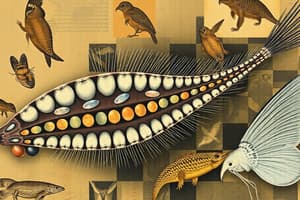Podcast
Questions and Answers
What are the 4 classes of phylum Platyhelminthes?
What are the 4 classes of phylum Platyhelminthes?
- Class Cestoda (correct)
- Class Monogenea (correct)
- Class Trematoda (correct)
- Class Turbellaria (correct)
What class in phylum Platyhelminthes is free-living?
What class in phylum Platyhelminthes is free-living?
Class Turbellaria
What is the genus of a free-living turbellarian?
What is the genus of a free-living turbellarian?
Dugesia
In what environment would you find a turbellarian?
In what environment would you find a turbellarian?
What are the 3 ways in which a turbellarian moves?
What are the 3 ways in which a turbellarian moves?
Turbellarians are omnivores.
Turbellarians are omnivores.
What do turbellarians eat?
What do turbellarians eat?
What structure do turbellarians use to eat?
What structure do turbellarians use to eat?
Why are turbellarians called 'potty mouths'?
Why are turbellarians called 'potty mouths'?
What type of digestive system do turbellarians have?
What type of digestive system do turbellarians have?
How does food get to the cells in various parts of the turbellarian's body?
How does food get to the cells in various parts of the turbellarian's body?
What type of nervous system do turbellarians have?
What type of nervous system do turbellarians have?
What is the ganglia?
What is the ganglia?
The ganglia is located at the anterior end of the turbellarian's body.
The ganglia is located at the anterior end of the turbellarian's body.
What are ocelli?
What are ocelli?
What does ocelli literally mean?
What does ocelli literally mean?
What are auricles?
What are auricles?
Auricles are located on the sides of the turbellarian's head.
Auricles are located on the sides of the turbellarian's head.
In what system does water remain constant throughout the turbellarian?
In what system does water remain constant throughout the turbellarian?
What process does the excretory system use to evenly distribute the water?
What process does the excretory system use to evenly distribute the water?
What would happen if the turbellarian would absorb too much water?
What would happen if the turbellarian would absorb too much water?
What would happen if the turbellarian wouldn't absorb enough water?
What would happen if the turbellarian wouldn't absorb enough water?
Removing waste is the primary function of flame cells.
Removing waste is the primary function of flame cells.
How do turbellarians reproduce?
How do turbellarians reproduce?
What type(s) of asexual reproduction do turbellarians use?
What type(s) of asexual reproduction do turbellarians use?
What kinds of binary fission are there?
What kinds of binary fission are there?
Transverse division is when the turbellarian is split across the x-axis.
Transverse division is when the turbellarian is split across the x-axis.
Longitudinal division is when the turbellarian is split across the y-axis.
Longitudinal division is when the turbellarian is split across the y-axis.
Turbellarians are (monoecious, hermaphrodites, dioecious).
Turbellarians are (monoecious, hermaphrodites, dioecious).
What hatches from the turbellarian's egg?
What hatches from the turbellarian's egg?
In general, which of the following classes contain parasitic members?
In general, which of the following classes contain parasitic members?
Ganglia refers to?
Ganglia refers to?
Auricles are?
Auricles are?
Flashcards are hidden until you start studying
Study Notes
Phylum Platyhelminthes Overview
- Comprised of four classes: Class Turbellaria, Class Monogenea, Class Trematoda, Class Cestoda.
- Class Turbellaria holds free-living members.
Turbellaria Characteristics
- Genus of free-living turbellarians: Dugesia.
- Found in diverse aquatic environments (lakes, ponds, rivers, seas) and moist terrestrial areas.
Locomotion and Feeding
- Movement achieved through cilia, undulation, and mucous for climbing.
- Diet consists of invertebrates, protozoans, and decomposed animals.
- Pharynx is the structure used for feeding, with dual purpose as waste excretory opening.
Digestive System
- Turbellarians possess an incomplete digestive system.
- Nutrients diffuse directly into body cells.
Nervous System and Sensory Structures
- Ladder-like nervous system featuring longitudinal nerve cords.
- Ganglia serve as a simple brain located at the anterior end.
- Ocelli, or "little eyes," function as light detectors.
- Auricles act as sensory lobes for environmental interaction and are located on the sides of the head.
Excretion and Water Regulation
- Excretory system maintains constant water levels, utilizing osmosis for distribution.
- Over-absorption of water can lead to cell rupture; too little water causes cellular shrinkage and potential death.
- Flame cells primarily remove excess water, with waste removal as a secondary function.
Reproduction
- Turbellarians can reproduce both asexually (via binary fission and budding) and sexually.
- Types of asexual reproduction include transverse and longitudinal binary fission.
- They are monoecious and hermaphroditic, producing "miniature adults" from eggs.
Parasitic Classes
- Class Turbellaria is free-living, while classes Monogenea, Trematoda, and Cestoda include parasitic members.
Key Definitions
- Ganglia: Mass of nerve cells providing basic brain functions.
- Auricles: Sensory structures for detecting surroundings.
Studying That Suits You
Use AI to generate personalized quizzes and flashcards to suit your learning preferences.




